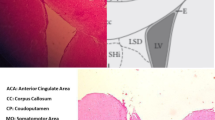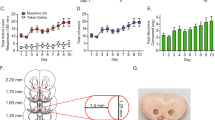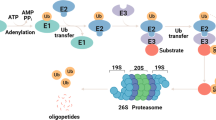Abstract
Plastic changes in the nucleus accumbens (NAcc), a structure occupying a key position in the neural circuitry related to motivation, are among the critical cellular processes responsible for drug addiction. During the last decade, it has been shown that memory formation and related neuronal plasticity may rely not only on protein synthesis but also on protein degradation by the ubiquitin proteasome system (UPS). In this study, we assess the role of protein degradation in the NAcc in opiate-related behaviors. For this purpose, we coupled behavioral experiments to intra-accumbens injections of lactacystin, an inhibitor of the UPS. We show that protein degradation in the NAcc is mandatory for a full range of animal models of opiate addiction including morphine locomotor sensitization, morphine conditioned place preference, intra-ventral tegmental area morphine self-administration and intra-venous heroin self-administration but not for discrimination learning rewarded by highly palatable food. This study provides the first evidence of a specific role of protein degradation by the UPS in addiction.
Similar content being viewed by others
Log in or create a free account to read this content
Gain free access to this article, as well as selected content from this journal and more on nature.com
or
References
Alberini CM (2005). Mechanisms of memory stabilization: are consolidation and reconsolidation similar or distinct processes? Trends Neurosci 28: 51–56.
Ande SR, Chen J, Maddika S (2009). The ubiquitin pathway: an emerging drug target in cancer therapy. Eur J Pharmacol 625: 199–205.
Artinian J, McGauran AM, De Jaeger X, Mouledous L, Frances B, Roullet P (2008). Protein degradation, as with protein synthesis, is required during not only long-term spatial memory consolidation but also reconsolidation. Eur J Neurosci 27: 3009–3019.
Badiani A, Robinson TE (2004). Drug-induced neurobehavioral plasticity: the role of environmental context. Behav Pharmacol 15: 327–339.
Baudonnat M, Guillou JL, Husson M, Vandesquille M, Corio M, Decorte L et al (2011). Disrupting effect of drug-induced reward on spatial but not cue-guided learning: implication of the striatal protein kinase A/cAMP response element-binding protein pathway. J Neurosci 31: 16517–16528.
Belin D, Jonkman S, Dickinson A, Robbins TW, Everitt BJ (2009). Parallel and interactive learning processes within the basal ganglia: relevance for the understanding of addiction. Behav Brain Res 199: 89–102.
Cardinal RN, Everitt BJ (2004). Neural and psychological mechanisms underlying appetitive learning: links to drug addiction. Curr Opin Neurobiol 14: 156–162.
Carle TL, Ohnishi YN, Ohnishi YH, Alibhai IN, Wilkinson MB, Kumar A et al (2007). Proteasome-dependent and -independent mechanisms for FosB destabilization: identification of FosB degron domains and implications for DeltaFosB stability. Eur J Neurosci 25: 3009–3019.
Chauvet C, Lardeux V, Goldberg SR, Jaber M, Solinas M (2009). Environmental enrichment reduces cocaine seeking and reinstatement induced by cues and stress but not by cocaine. Neuropsychopharmacology 34: 2767–2778.
Chen D, Frezza M, Schmitt S, Kanwar J, Ping DQ (2011). Bortezomib as the first proteasome inhibitor anticancer drug: current status and future perspectives. Curr Cancer Drug Targets 11: 239–253.
Citri A, Soler-Llavina G, Bhattacharyya S, Malenka RC (2009). N-methyl-D-aspartate receptor- and metabotropic glutamate receptor-dependent long-term depression are differentially regulated by the ubiquitin-proteasome system. Eur J Neurosci 30: 1443–1450.
Conrad KL, Tseng KY, Uejima JL, Reimers JM, Heng LJ, Shaham Y et al (2008). Formation of accumbens GluR2-lacking AMPA receptors mediates incubation of cocaine craving. Nature 454: 118–121.
Contet C, Filliol D, Matifas A, Kieffer BL (2008). Morphine-induced analgesic tolerance, locomotor sensitization and physical dependence do not require modification of mu opioid receptor, cdk5 and adenylate cyclase activity. Neuropharmacology 54: 475–486.
David V, Durkin TP, Cazala P (2002). Differential effects of the dopamine D2/D3 receptor antagonist sulpiride on self-administration of morphine into the ventral tegmental area or the nucleus accumbens. Psychopharmacology 160: 307–317.
Dong C, Upadhya SC, Ding L, Smith TK, Hegde AN (2008). Proteasome inhibition enhances the induction and impairs the maintenance of late-phase long-term potentiation. Learn Mem 15: 335–347.
Dunah AW, Standaert DG (2001). Dopamine D1 receptor-dependent trafficking of striatal NMDA glutamate receptors to the postsynaptic membrane. J Neurosci 21: 5546–5558.
Fioravante D, Byrne JH (2011). Protein degradation and memory formation. Brain Res Bull 85: 14–20.
Fonseca R, Vabulas RM, Hartl FU, Bonhoeffer T, Nagerl UV (2006). A balance of protein synthesis and proteasome-dependent degradation determines the maintenance of LTP. Neuron 52: 239–245.
Girault JA, Valjent E, Caboche J, Herve D (2007). ERK2: a logical AND gate critical for drug-induced plasticity? Curr Opin Pharmacol 7: 77–85.
Hegde AN (2010). The ubiquitin-proteasome pathway and synaptic plasticity. Learn Mem 17: 314–327.
Hyman SE, Malenka RC, Nestler EJ (2006). Neural mechanisms of addiction: the role of reward-related learning and memory. Annu Rev Neurosci 29: 565–598.
Kaang BK, Choi JH (2011). Protein degradation during reconsolidation as a mechanism for memory reorganization. Front Behav Neurosci 5: 2.
Karpova A, Mikhaylova M, Thomas U, Knopfel T, Behnisch T (2006). Involvement of protein synthesis and degradation in long-term potentiation of Schaffer collateral CA1 synapses. J Neurosci 26: 4949–4955.
Kasanetz F, Deroche-Gamonet V, Berson N, Balado E, Lafourcade M, Manzoni O et al (2010). Transition to addiction is associated with a persistent impairment in synaptic plasticity. Science 328: 1709–1712.
Kauer JA, Malenka RC (2007). Synaptic plasticity and addiction. Nat Rev Neurosci 8: 844–858.
Kelley AE (2004). Memory and addiction; shared neural circuitry and molecular mechanisms. Neuron 44: 161–179.
Kisselev AF, Goldberg AL (2001). Proteasome inhibitors: from research tools to drug candidates. Chem Biol 8: 739–758.
Lee SH, Choi JH, Lee N, Lee HR, Kim JI, Yu NK et al (2008). Synaptic protein degradation underlies destabilization of retrieved fear memory. Science 319: 1253–1256.
Lopez-Salon M, Alonso M, Vianna MR, Viola H, Mello e Souza T, Izquierdo I et al (2001). The ubiquitin-proteasome cascade is required for mammalian long-term memory formation. Eur J Neurosci 14: 1820–1826.
Mameli M, Halbout B, Creton C, Engblom D, Parkitna JR, Spanagel R et al (2009). Cocaine-evoked synaptic plasticity: persistence in the VTA triggers adaptations in the NAc. Nat Neurosci 12: 1036–1041.
Marchand S, Betourne A, Marty V, Daumas S, Halley H, Lassalle JM et al (2006). A neuropeptide FF agonist blocks the acquisition of conditioned place preference to morphine in C57Bl/6J mice. Peptides 27: 964–972.
McClung CA, Nestler EJ (2008). Neuroplasticity mediated by altered gene expression. Neuropsychopharmacology 33: 3–17.
Mouledous L, Neasta J, Uttenweiler-Joseph S, Stella A, Matondo M, Corbani M et al (2005). Long-term morphine treatment enhances proteasome-dependent degradation of G beta in human neuroblastoma SH-SY5Y cells: correlation with onset of adenylate cyclase sensitization. Mol Pharmacol 68: 467–476.
Mouledous L, Frances B, Zajac JM (2010). Modulation of basal and morphine-induced neuronal activity by a NPFF(2) selective agonist measured by c-Fos mapping of the mouse brain. Synapse 64: 672–681.
Moulédous L, Merker S, Neasta J, Roux B, Zajac JM, Mollereau C (2008). Neuropeptide FF-sensitive confinement of mu opioid receptor does not involve lipid rafts in SH-SY5Y cells. Biochem Biophys Res Commun 373: 80–84.
Pascoli V, Turiault M, Lüscher C (2011). Reversal of cocaine-evoked synaptic potentiation resets drug-induced adaptive behaviour. Nature 481: 71–75.
Robbins TW, Ersche KD, Everitt BJ (2008). Drug addiction and the memory systems of the brain. Ann NY Acad Sci 1141: 1–21.
Robbins TW, Everitt BJ (1996). Neurobehavioural mechanisms of reward and motivation. Curr Opin Neurobiol 6: 228–236.
Sun X, Wolf ME (2009). Nucleus accumbens neurons exhibit synaptic scaling that is occluded by repeated dopamine pre-exposure. Eur J Neurosci 30: 539–550.
Tzschentke TM (1998). Measuring reward with the conditioned place preference paradigm: a comprehensive review of drug effects, recent progress and new issues. Prog Neurobiol 56: 613–672.
Vanderschuren LJ, Kalivas PW (2000). Alterations in dopaminergic and glutamatergic transmission in the induction and expression of behavioral sensitization: a critical review of preclinical studies. Psychopharmacology 151: 99–120.
Yang L, Wang S, Lim G, Sung B, Zeng Q, Mao J (2008a). Inhibition of the ubiquitin-proteasome activity prevents glutamate transporter degradation and morphine tolerance. Pain 140: 472–478.
Yang L, Wang S, Sung B, Lim G, Mao J (2008b). Morphine induces ubiquitin-proteasome activity and glutamate transporter degradation. J Biol Chem 283: 21703–21713.
Zernig G, Wakonigg G, Madlung E, Haring C, Saria A (2004). Do vertical shifts in dose-response rate-relationships in operant conditioning procedures indicate "sensitization" to "drug wanting"? Psychopharmacology (Berl) 171: 349–351 author reply 352–363.
Acknowledgements
We thank Julien Familiades, Fanny Botreau, Ingrid Waldschmidt, and Claudia Chauvet for help in behavioral procedures (place preference, behavioral sensitization, and intra-venous self-administration); Claire Rampon and Magaly Alonso for help with the immunohistochemistry; Helene Halley for technical assistance and animal care; Jean-Pierre Changeux, Peter Redgrave, Nasser Haddjeri, Manuel Mameli, and Fred Ambroggi for their useful comments on the manuscript.
Author information
Authors and Affiliations
Corresponding author
Ethics declarations
Competing interests
The authors declare no conflict of interest.
Additional information
Supplementary Information accompanies the paper on the Neuropsychopharmacology website
Supplementary information
Rights and permissions
About this article
Cite this article
Massaly, N., Dahan, L., Baudonnat, M. et al. Involvement of Protein Degradation by the Ubiquitin Proteasome System in Opiate Addictive Behaviors. Neuropsychopharmacol 38, 596–604 (2013). https://doi.org/10.1038/npp.2012.217
Received:
Revised:
Accepted:
Published:
Issue date:
DOI: https://doi.org/10.1038/npp.2012.217
Keywords
This article is cited by
-
Ube2b-dependent degradation of DNMT3a relieves a transcriptional brake on opiate-induced synaptic and behavioral plasticity
Molecular Psychiatry (2021)
-
Genome-wide transcriptional profiling of central amygdala and orbitofrontal cortex during incubation of methamphetamine craving
Neuropsychopharmacology (2018)
-
Response of the Ubiquitin-Proteasome System to Memory Retrieval After Extended-Access Cocaine or Saline Self-Administration
Neuropsychopharmacology (2015)



